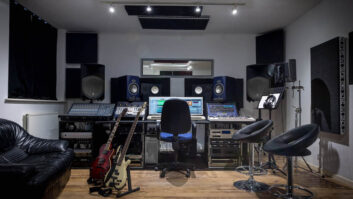Perhaps best known as the distributors for Mogami cable, Marshall
Electronics recently introduced two condenser microphones: the MXL2001-P and MXL2003.
The MXL2001-P has been designed for the budget-minded studio owner,
while the MXL2003 is intended for more critical recording
applications.
Introduced approximately one year ago, the MXL2001-P has, in recent
months, been re-engineered. Its upscale sibling, the MXL2003, is quite
new to the market. The two jet-black instruments, at first glance,
appear almost identical; however, they are quite distinct in both their
components and circuitry, as well as in their performance.
With both microphones, Marshall has put its resources into the
performance characteristics of the instruments as opposed to the
packaging. Unlike mics that ship with cases that resemble treasure
chests (not that a good mic isn’t a treasure), the MXL2001-P and
MXL2003 are shipped in modest cardboard boxes. But these two
microphones are much more capable of capturing the essence of a
performance or the spoken word than their modest packaging
suggests.
The MXL2001-P The $199 MXL2001-P employs a 25mm (1-inch) diameter,
gold-sputtered diaphragm that is 6 microns thick. The capsule is
coupled through an electromagnetic screen to a FET preamp with a
balanced transformer output. The microphone is encased in a heavy brass
enclosure, which gives the unit a very substantial feel. The MXL2001-P
comes with a screw-on mic stand adapter and a storage pouch. An MXL-56
shock-mount is optional.
Without getting too caught up in the specs, it is important to note
that the MXL2001-P has a single cardioid polar pattern and a frequency range of 30 to 20k
Hz. The microphone is phantom-powered and has a S/N ratio of 80 dB referenced to 1 Pa, A-weighted. There are no
switches for pre-attenuation or bass cut.
The MXL2003 By contrast, the $399 MXL2003 uses a slightly larger,
27mm (1.06-inch) and thinner (3-micron) gold-sputtered diaphragm. The
capsule is coupled through an electromagnetic screen to a FET preamp
with a wideband transformerless output. Like the MXL2001-P, the MXL2003
is housed in a heavy brass enclosure. Unlike the MXL2001-P, this
microphone ships with the MXL-56 shock-mount adapter, but no storage
pouch.
The MXL2003’s basic specifications include a single cardioid polar
pattern and a frequency range of 20 to 23k Hz. The microphone is
phantom-powered and has a S/N ratio of 77 dB referenced to 1 Pa,
A-weighted. The MXL2003 has a three-position switch for bass cut (-6
dB/octave at 150 Hz) and pre-attenuation (0/-10 dB).
IN SESSION
My first experience with these microphones involved recording a local
band where I used them to record the output of a guitar amplifier. Both microphones are extremely
sensitive, and I found that microphone placement had a significant
impact on the signal I was receiving at the board. The difference of 12
inches right/left of center and from the cabinet was surprisingly
apparent.
Both mics captured the amplifier’s output very capably, given the
high sound pressure levels of the amp. While the MXL2001-P seemed quite
tolerant of the sound pressure levels, I ultimately came to rely on the
MXL2003. Initially, the MXL2003 was on the verge of distorting, but by
engaging the microphone’s pad, I took care of the problem with the
throw of a switch and achieved a sound that more accurately reflected
the nature of the performance.
I used both mics in my studio for a considerable amount of
close-proximity dialog recording. In order to get a clear, dry sound
typical of broadcast production, I positioned the mics roughly three to
four inches from the speaker’s mouth with a pop filter placed between
the mic and talent.
Both microphones exhibited a big, well-rounded sound that accurately
conveyed the nuances of the talent’s voice and articulation. Without
any editing, the voice-over tracks had a pleasing quality, which
translates to less work after the session. The MXL2001-P delivered a
crisp, uncolored sound that works very nicely for vocal and dialog
work. Compared to the MXL2001-P, the MXL2003 has considerably more
depth of character in the lower frequencies—not a low-end
coloration, but a certain fullness that sounds considerably more
expensive than this mic actually costs.
It should also be noted that the MXL-56 shock-mount secured the
microphones with a light touch while isolating them from common floor
vibrations.
CONCLUSION
Marshall Electronics’ MXL2001-P and MXL2003 are two condenser mics that
are capable of handling numerous recording tasks competently. The
MXL2001-P is a straight-ahead, plug-and-play type of instrument without
any controls whatsoever, yet it records with a nice, open sound that
will cut through just about any mix. Such characteristics make this
microphone a good choice for the smaller studio that focuses most of
its efforts on the recording of popular music.
With a noticeably fuller quality to its sound and a slightly better
balanced on-axis response than its sibling, the MXL2003 strikes me as a
mic that could very easily find a home in broadcast, ADR and Foley
applications, in addition to a multitude of music chores. Although it
still has just a single polar pattern, its three-position switch for
pre-attenuation and bass cut make this microphone considerably more
versatile.
In terms of workmanship, these products have a look and feel that is
the mark of well-made equipment. At this price point, there really
isn’t anything to complain about-unless you’re expecting first-class
luggage as part of the deal. As for the fancy case, I’d rather have the
benefits these mics bring to the party.
Marshall Electronics Professional Audio Division, www.mars-cam.com







